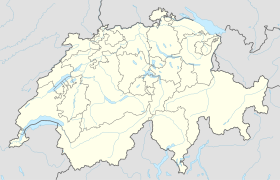Goumoens-la-Ville
| Goumoens-la-Ville | ||
|---|---|---|
| State : |
|
|
| Canton : |
|
|
| District : | Gros-de-Vaud | |
| Municipality : | Goumoëns | |
| Postal code : | 1376 | |
| former BFS no. : | 5524 | |
| Coordinates : | 536193 / 167704 | |
| Height : | 618 m above sea level M. | |
| Area : | 7.27 km² | |
| Residents: | 660 (December 31, 2010) | |
| Population density : | 91 inhabitants per km² | |
| Website: | www.goumoens-la-ville.ch | |
| map | ||
|
|
||
Goumoens-la-Ville was a municipality in the Gros-de-Vaud district in the canton of Vaud in Switzerland . On July 1, 2011, Goumoens-la-Ville was incorporated into the new Goumoëns municipality .
geography
Goumoens-la-Ville is 618 m above sea level. M. , three kilometers northwest of Echallens and 16 kilometers north of the canton capital Lausanne (as the crow flies). The village is located on the vast plateau of the central Gros de Vaud , east of talent , in the Vaud Plateau .
The area of the 7.3 km² former municipal area covers a section of the gently undulating high plateau of the Gros de Vaud, the granary of the canton of Vaud. The plateau has an average height of 610 m above sea level in the area of Goumoens-la-Ville . M. on. To the south, the municipality extends to the Talent on the edge of the Bois du Mont forest area , to the west to the edge of the Talent valley and the source of the Vouda brook . The north-eastern part of the municipality is occupied by the vast forests of Grands Bois and Bois de la Repe , from which the source streams of the Buron arise. The highest point of Goumoens-la-Ville is 661 m above sea level. M. at the height of Montanare on the edge of this forest area. In 1997, 4% of the municipal area was accounted for by settlements, 20% for forests and trees and 76% for agriculture.
Numerous individual farms belonged to the municipality of Goumoens-la-Ville. Neighboring municipalities of Goumoens-la-Ville were Echallens , Saint-Barthélemy , Eclagnens , Goumoens-le-Jux , Penthéréaz and Villars-le-Terroir .
population
With 660 inhabitants (as of December 31, 2010) Goumoens-la-Ville was one of the smaller municipalities in the canton of Vaud. 95.9% of the residents are French-speaking, 1.6% German-speaking and 0.7% English-speaking (as of 2000). The population of Goumoens-la-Ville was 443 in 1850 and 449 in 1900. After the population had decreased to 361 people by 1970, a significant increase in population was recorded again, with the number of inhabitants almost doubling within 30 years.
economy
Goumoens-la-Ville was a predominantly agricultural village until the second half of the 20th century . Even today, arable farming (especially grain, sugar beet and rapeseed), fruit growing and cattle breeding have a certain importance in the income structure of the population. Further jobs are available in small businesses and in the service sector. With the growth of the population since the 1970s, some smaller companies also settled in town (in the fields of IT and electrical engineering). In the last few decades the village has also developed into a residential community. Many workers are therefore commuters who work mainly in Echallens and the greater Lausanne area.
traffic
Goumoens-la-Ville has good transport connections, although it is located on a cantonal road from Echallens to Chavornay , away from major thoroughfares . The La Sarraz motorway junction on the A1 (Lausanne-Yverdon) opened in 1981 is only around 3 km from the town center. Goumoens-la-Ville is connected to the public transport network by a postbus course that runs from Echallens to Chavornay.
history
The place was first mentioned in a document in 1228 under the name Guimuens li vila . Later the names Gomoens , Gomuens , Gumuens and Gumoyns appeared . The place name is derived from the Burgundian personal name Gudemod .
In the Middle Ages , Goumoens-la-Ville initially belonged to the Goumoens rule of the noble family of the same name, which was mentioned in the 11th century and resided in Goumoens-le-Châtel, today's Saint-Barthélemy . Parts of the place also belonged to the Bishop of Lausanne and the cathedral chapter. In the course of the 13th century, the non-contiguous domain was split into three parts. The resulting Goumoens-la-Ville rule was ruled by a branch of the Goumoens family, who had their seat in the Château-Dessous and in 1447 also acquired the Goumoens-le-Jux rule.
After the Burgundian Wars , Goumoens-la-Ville came to the Orbe-Echallens Bailiwick in 1476 , which was under the common rule of Bern and Friborg . The Reformation was not accepted by the villagers until 1575. After the collapse of the Ancien Régime , the village belonged to the canton of Léman from 1798 to 1803 during the Helvetic Republic, which then became part of the canton of Vaud when the mediation constitution came into force . In 1798 it was assigned to the Echallens district.
Attractions
The reformed parish church was mentioned in the 12th century as the center of a large parish, to which Echallens also belonged. It was initially under the Abbey of Montbenoît in France , after 1476 the Abbey of Lac de Joux ( L'Abbaye ). The church was redesigned and restored in the 15th and 16th centuries and in 1848 and is now a listed building. Gothic wall paintings from the 14th century have been preserved inside .
The castle (Château-Dessous) comes from the Middle Ages and has three square towers and a prison tower. The residential buildings were built in the 17th and 18th centuries. Today the castle houses a social medicine center as well as a retirement and nursing home. In the center of Goumoens-la-Ville there are some typical farmhouses from the 17th to 19th centuries. The landmark of the place is a 37 m high water tower built around 1940, visible from afar, on the hilltop north of the village.


